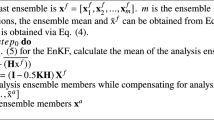Abstract
The performance of an inexpensive, ensemble-based optimal interpolation (EnOI) scheme that uses a stationary ensemble of model anomalies to approximate forecast error covariances, is compared with that of an ensemble Kalman filter (EnKF). The model to which the methods are applied is a pair of “perfect”, one-dimensional, linear advection equations for two related variables. While EnOI is sub-optimal, it can give results that are comparable to those of the EnKF. The computational cost of EnOI is typically about \(N\) times less than that of EnKF, where \(N\) is the ensemble size. We suggest that EnOI may provide a practical and cost-effective alternative to the EnKF for some applications where computational cost is a limiting factor. We demonstrate that when the ensemble size is smaller than the dimension of the model’s sub-space, both the EnKF and EnOI may require localisation around each observation to eliminate effects of sampling error and to increase the effective number of independent ensemble members used to construct an analysis. However, localisation can degrade an analysis if the length-scales of the localising function are too short. We demonstrate that, as the length-scale of the localising function is decreased, localisation can significantly compromise the model’s dynamical balances. We also find that localisation artificially amplifies high frequencies for applications of the EnKF. Based on our experiments, for applications where localisation is necessary, the length-scales of the localisation should be larger than the decorrelation length-scales of the variables being updated.
Similar content being viewed by others
References
Anderson JL, Anderson SL (1999) A Monte Carlo implementation of the nonlinear filtering problem to produce ensemble assimilations and forecasts. Mon Weather Rev 127:2741–2758
Evensen G (2003) The ensemble Kalman filter: theoretical formulation and practical implementation. Ocean Dyn 53:343–367
Evensen G (2004) Sampling strategies and square root analysis schemes for the EnKF. Ocean Dyn 54:539–560
Hamill TM, Whitaker JS, Snyder C (2001) Distance-dependent filtering of background error covariance estimates in an ensemble Kalman filter. Mon Weather Rev 129:2776–2790
Houtekamer PL (1995) The construction of optimal perturbations. Mon Weather Rev 123:2888–2898
Houtekamer PL, Mitchell HL (1998) Data assimilation using an ensemble Kalman filter technique. Mon Weather Rev 126:796–811
Houtekamer PL, Mitchell HL (2001) A sequential ensemble Kalman filter for atmospheric data assimilation. Mon Weather Rev 129:123–137
Keppenne CL (2000) Data assimilation into a primitive-equation model with a parallel ensemble Kalman filter. Mon Weather Rev 128:1971–1981
Keppenne CL, Rienecker M (2002) Initial testing of a massively parallel ensemble Kalman filter with the poseidon isopycnal ocean general circulation model. Mon Weather Rev 130:2951–2965
Mitchell HL, Houtekamer PL, Pellerin G (2002) Ensemble size, balance, and model-error representation in an ensemble Kalman filter. Mon Weather Rev 130:2791–2808
Nerger L, Hiller W, Schroter J (2005) A comparison of error subspace Kalman filters. Tellus 57A:715–735
Oke PR, Allen JS, Miller RN, Egbert GD, Kosro PM (2002) Assimilation of surface velocity data into a primitive equation coastal ocean model. J Geophys Res 107, DOI 10.1029/200JC000511
Oke PR, Schiller A, Griffin DA, Brassington GB (2005) Ensemble data assimilation for an eddy-resolving ocean model of the Australian region. Q J R Meteorol Soc 131:3301–3311
Ott E, Hunt BR, Szunyogh I, Zimin AV, Kostelich EJ, Corazza M, Kalnay E, Patil DJ, Yorke JA (2004) A local ensemble Kalman filter for atmospheric data assimilation. Tellus 56A:415–428
Whitaker JS, Hamill TM (2002) Ensemble data assimilation without perturbed observations. Mon Weather Rev 130:1913–1924
Author information
Authors and Affiliations
Corresponding author
Additional information
Responsible editor: Jörg-Olaf Wolff
Rights and permissions
About this article
Cite this article
Oke, P.R., Sakov, P. & Corney, S.P. Impacts of localisation in the EnKF and EnOI: experiments with a small model. Ocean Dynamics 57, 32–45 (2007). https://doi.org/10.1007/s10236-006-0088-8
Received:
Accepted:
Published:
Issue Date:
DOI: https://doi.org/10.1007/s10236-006-0088-8




